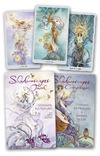An Interview with Stephanie Pui-Mun Law
1. The art for Shadowscapes Tarot is breathtakingly beautiful. From where did you draw inspiration when creating this deck?
For the imagery in this deck, I drew a lot from various myths around the world, weaving them together into my own melded landscape. Much of my inspiration also comes from nature: the flow and rhythms of the seasons, of growth, of the dance of life, and the beauty in death and renewal. That aspect of nature is obvious in the profusion of animals that appear in my cards, but also I like to think more subtly in the overall flow and movement in each, and the visual randomness that nature presents.
2. You already have a following for your art; is most of your work similar to that of the deck?
My art has always been a way for me to explore mythology, fairy tales, and folklore. I enjoy having my images tell a tale, inviting the viewer into a realm that exists in a way, alongside ours; that of the imagination, dreams, and possibilities. Collective perception defining this reality, and the others being shadows of that—in other words: shadowscapes. Mythology is a language of archetypes. As such, painting a tarot deck seemed a natural extension of my body of work. Even now that I have finished the deck, when I work on new paintings, I seem to feel the energy of various cards reverberating in them. After having spent so long (five years) thinking, creating, and meditating on tarot symbolism, it is hard for me not to think in terms of those cards in all of my art, because those 78 cards encompass such a huge spread of the human experience.
3. Where did you get your start as an artist?
I started off with my art as a side career to programming. At first it was relegated to the night after a busy day at software. I did quite a bit of work for the fantasy games industry at first, and after several years of moonlighting, I left programming to pursue the art full time.
By then I started noticing that even within the bounds of the gaming industry, the types of jobs I took on frequently had a common theme of mythology and the otherworld. Publishers started seeking me out for that type of work in particular as well, rather than the myriad other themes in the gaming industry.
After leaving software, the extra free time gave me the chance to expand more on my personal body of art, instead of dedicating it all to contract work. The focus my personal work took on became more obvious over the years. These days I don't do very much gaming work. Most of my time is spent on personal projects like that tarot, a zodiac, and paintings that explore a personal mythos.
4. The deck is in the Rider-Waite-Smith tradition, but deviates in the imagery. Why did you decide to differ in this fashion?
It was my way of connecting with each card. When I would start to work on a card I gathered together my notes for a few keywords that I distilled from dozens of decks. Then, without looking at other representations, I would try to draw my own associations with those words, and to feel the symbols that would surface when meditating on a concept. While not wanting to just utilize the same imagery that someone else may have created for a card, I did draw upon mythologies around the world for various ideas and symbols and associations. These are things that are collectively understood, appearing again and again in stories across cultures, and as such are a sort of universal language.
5. Shadowscapes Tarot draws on a number of different sources in its symbolism; from where did you draw the folklore and myth when creating the deck?
From wherever I could find it! I started with those that are most familiar to me, but branched out to more obscure sources as well. For example, instead of just European style unicorns—white deer-like creatures with cloven hooves and horns—I included Asian-style unicorns as well. These are called Kierun, in their various incarnations and as described in different Asian cultures. Some are more lion-like, some almost like dragons, but are still a unicorn of sorts.
Sometimes the associations came to me after I created the image, as if my subconscious was at work in the design. The Two of Pentacles took on the aspect of the Hindu deity Shiva, in his balanced dance of creation and destruction, while the Queen of Pentacles seemed to bear the hidden guise of Durga, with the fan of branches reminiscent of the goddess's arms, embodiment of feminine creative energy.
The foxes in the Wands suit became lithe and living symbols of flame, being creatures of sparking wit and curiosity in so many fables and tales: from trickster shapeshifting kitsune in Japanese lore to clever Mister Reynard of Aesop's fables.
6. What was it like working with tarot author Barbara Moore in the creation of Shadowscapes Tarot?
I had met Barbara briefly at a FaeryCon convention in Philadelphia a few years ago, and she had subsequently contacted me through email about working with me for the text of the deck. I wanted to write the text for the cards myself, because there was a tale that each card needed to have told—the stories that had worked their way into the cards as I painted. But Barbara was able to work with me to fill in the gaps in my tarot knowledge.Her experience was able to nicely compliment the material that I had.

